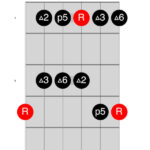How To Play Gypsy Fleetwood Mac On Guitar is a popular search among guitar enthusiasts, and at guitarplayers.net, we’re here to guide you through every strum and chord. This article will break down the techniques and approaches that bring this iconic song to life on your guitar, so you can master it with confidence and flair, exploring guitar tabs, chord progressions, and easy-to-follow lessons. Dive in to discover the joy of playing Fleetwood Mac’s “Gypsy” and enhance your guitar playing skills.
1. Understanding The Allure Of “Gypsy”
What Makes “Gypsy” Such A Captivating Song To Play On Guitar?
“Gypsy” captivates with its unique blend of folk-rock and dreamy melodies, making it a rewarding challenge for guitarists to learn. The song’s arrangement is characterized by fingerpicking patterns and chord voicings that create an ethereal soundscape. Learning “Gypsy” is not just about mastering the notes; it’s about capturing the emotion and storytelling woven into the music. Stevie Nicks’ lyrics evoke a sense of nostalgia and wanderlust, which resonates deeply with listeners and players alike. The song also features subtle dynamic changes and rhythmic nuances that add depth and complexity, providing an excellent opportunity to refine your guitar playing skills.
Why Is “Gypsy” Such A Popular Choice Among Guitar Players?
“Gypsy” is a popular choice for guitar players because it offers a balanced challenge, appealing to both beginners and experienced players. The song’s chord progression is relatively straightforward, making it accessible for beginners to learn basic chords and strumming patterns. However, the intricate fingerpicking patterns and unique chord voicings provide a challenge for more advanced players, allowing them to explore new techniques and enhance their skills. “Gypsy” also offers opportunities for improvisation and personal expression, enabling guitarists to put their unique spin on the song. The song’s widespread popularity and cultural significance make it a crowd-pleaser, ensuring that your performance will be well-received.
2. Getting Started: Essential Gear And Setup
What Type Of Guitar Is Best Suited For Playing “Gypsy”?
An acoustic guitar is best suited for playing “Gypsy,” as it captures the song’s intimate and folk-inspired feel. While any acoustic guitar can work, a model with a warm and balanced tone will best complement the song’s melodic qualities. Dreadnought guitars are popular for their full sound and projection, making them suitable for strumming and fingerpicking. Concert or grand auditorium guitars offer a more focused and articulate sound, which can be ideal for highlighting the song’s intricate fingerpicking patterns. Ultimately, the best guitar is the one that feels comfortable and sounds pleasing to your ear.
What Other Equipment Will Enhance My Playing Experience?
To enhance your playing experience, consider investing in a few essential accessories that can improve your comfort, sound, and performance. A quality guitar strap is crucial for playing while standing, ensuring that your guitar is securely in place. A clip-on tuner will help you keep your guitar in tune, which is essential for achieving the correct sound. Guitar picks in various thicknesses can help you experiment with different strumming styles and tones. A capo can be useful for transposing the song to different keys or for matching your vocal range. Finally, a guitar humidifier can help protect your instrument from damage caused by dry conditions, ensuring that it stays in optimal playing condition.
3. Breaking Down The Chords And Progressions
What Are The Main Chords Used In “Gypsy” And How Do I Finger Them?
“Gypsy” primarily uses a set of chords common in folk and rock music, making it relatively accessible for guitarists of all levels. Here are the main chords used in the song and how to finger them:
| Chord | Finger Placement |
|---|---|
| Am | Place your index finger on the 1st fret of the B string, your middle finger on the 2nd fret of the D string, and your ring finger on the 2nd fret of the G string. |
| G | Place your index finger on the 2nd fret of the A string, your middle finger on the 3rd fret of the low E string, and your ring finger on the 3rd fret of the high E string. |
| C | Place your index finger on the 1st fret of the B string, your middle finger on the 2nd fret of the D string, and your ring finger on the 3rd fret of the A string. |
| F | There are two common ways to play F: the full barre chord (barre your index finger across the entire 1st fret, then place your middle finger on the 2nd fret of the G string, your ring finger on the 3rd fret of the D string, and your pinky on the 3rd fret of the A string) or the simplified version (omit the barre and only play the 1st, 2nd, and 3rd strings). |
| Dm | Place your index finger on the 1st fret of the E string, your middle finger on the 2nd fret of the G string, and your ring finger on the 3rd fret of the B string. |
| Em | Place your middle finger on the 2nd fret of the A string and your ring finger on the 2nd fret of the D string. |
Practicing these chords individually before combining them into progressions will help you develop the necessary muscle memory and coordination. Focus on achieving clean and clear sound from each chord by ensuring that your fingers are pressing down firmly behind the frets and that you are strumming or picking the strings correctly.
Can You Explain The Chord Progression Used In “Gypsy”?
The chord progression in “Gypsy” is relatively simple, built around a series of commonly used chords in the keys of A minor and C major. The most common chord progression found in the song is Am – G – C – F, which creates a mellow, slightly melancholic feel that characterizes much of the song. This progression is repeated throughout various sections of the song, providing a foundation for the vocals and other instruments.
There are also variations in the chord progression, depending on the section of the song. For example, some sections may include chords like Dm or Em to add color and variety to the arrangement. In the bridge or chorus, you might find progressions that deviate slightly from the main pattern, creating contrast and building emotional intensity.
Understanding the chord progression is crucial for playing “Gypsy” accurately and expressively. By internalizing the sequence of chords and how they relate to each other, you’ll be able to anticipate changes, play along with the song more confidently, and add your personal touch to the performance.
4. Mastering The Strumming And Fingerpicking Techniques
What Strumming Pattern Best Suits “Gypsy”?
For “Gypsy”, a gentle, arpeggiated strumming pattern works best to capture the song’s ethereal feel. A basic pattern you can use is:
Down, Down-Up, Up
This pattern emphasizes the downstrokes, giving the song a steady rhythm, while the upstrokes add a subtle sense of movement. Focus on keeping your strumming hand relaxed and fluid, allowing the pick to glide smoothly across the strings. You can also experiment with variations of this pattern by adding or omitting certain strokes to create different rhythmic textures.
Another effective strumming pattern is a more subdued version that focuses on the bass notes and the higher strings:
Bass, Down-Up (on higher strings), Up
This pattern creates a fuller sound while still maintaining the song’s delicate quality. Pay attention to the dynamics of your strumming, varying the intensity to match the mood of the song. For example, you might strum more forcefully during the chorus to build energy and then soften your strumming during the verses to create a sense of intimacy.
How Can I Develop The Fingerpicking Skills Needed For “Gypsy”?
To develop fingerpicking skills for “Gypsy,” start by practicing basic fingerpicking patterns. A common pattern involves using your thumb for the bass notes (E, A, and D strings) and your index, middle, and ring fingers for the higher strings (G, B, and high E strings). A basic pattern to start with is:
Thumb (E or A string), Index (G string), Middle (B string), Ring (high E string)
Practice this pattern slowly and deliberately, focusing on maintaining a steady rhythm and even volume across all strings. Once you’re comfortable with this pattern, you can begin to incorporate it into the chord progressions of “Gypsy.” Start by playing the Am chord and applying the fingerpicking pattern, then transition smoothly to the next chord in the progression.
Another helpful exercise is to isolate specific sections of the song that feature intricate fingerpicking and practice them repeatedly until you can play them smoothly and accurately. Pay attention to the notes that each finger is responsible for and try to develop a consistent technique for plucking each string. Experiment with different fingerpicking patterns and techniques to find what works best for you and allows you to express the song’s emotion and beauty.
 Acoustic guitar chords diagram for practicing guitar
Acoustic guitar chords diagram for practicing guitar
5. Adding Embellishments And Variations
What Embellishments Can Enhance My Rendition Of “Gypsy”?
Adding embellishments can significantly enhance your rendition of “Gypsy,” making it sound more polished and expressive. One common embellishment is to incorporate hammer-ons and pull-offs, which involve quickly striking a string with a finger (hammer-on) or pulling a finger off a string (pull-off) to create a smooth, legato sound. These techniques can be used to add interest to individual notes or to create subtle melodic variations.
Another effective embellishment is to use slides, which involve sliding your finger along a string to move from one note to another. Slides can be used to connect chords or to add a sense of fluidity to your playing. You can also experiment with adding vibrato to certain notes, which involves slightly altering the pitch of the note to create a shimmering effect.
How Can I Create My Own Variations On The Song?
Creating your own variations on “Gypsy” is a great way to put your personal stamp on the song and make it your own. One approach is to experiment with different chord voicings, which involve playing the same chord in different positions on the neck to create different tonal colors. You can also try adding or substituting chords to create new harmonic possibilities.
Another way to create variations is to alter the rhythm or tempo of the song. For example, you could play the song at a slower tempo to give it a more melancholic feel, or you could speed it up to create a more energetic and upbeat version. You can also experiment with different strumming patterns or fingerpicking techniques to change the song’s rhythmic texture. Don’t be afraid to experiment and take risks – the key is to have fun and explore your creativity.
6. The Importance Of Dynamics And Expression
How Do Dynamics Contribute To The Emotional Impact Of “Gypsy”?
Dynamics play a crucial role in conveying the emotional depth of “Gypsy.” The song’s dynamic range helps to create a sense of ebb and flow, drawing the listener in and enhancing the storytelling. By varying the intensity of your playing, you can emphasize certain sections of the song, create contrast, and build emotional tension.
For example, you might play the verses softly and intimately, drawing the listener in with delicate fingerpicking or gentle strumming. As the song builds towards the chorus, you can increase the intensity of your playing, strumming more forcefully and adding more dynamic embellishments. This creates a sense of release and allows the chorus to stand out as the emotional high point of the song.
What Other Expressive Techniques Can I Use To Enhance My Performance?
In addition to dynamics, there are several other expressive techniques that you can use to enhance your performance of “Gypsy.” One technique is to vary your tone by adjusting your pick attack or finger placement. Playing closer to the bridge will produce a brighter, more articulate tone, while playing closer to the neck will produce a warmer, more mellow tone.
Another technique is to use bending, which involves pushing or pulling a string to slightly alter its pitch. Bending can be used to add emotion and expression to individual notes or to create subtle melodic variations. You can also experiment with adding slides, hammer-ons, and pull-offs to create a smoother, more legato sound.
Finally, don’t forget the importance of phrasing. Pay attention to the way that Stevie Nicks sings the lyrics and try to emulate her phrasing in your guitar playing. This involves paying attention to the pauses, accents, and rhythmic nuances of the song and incorporating them into your performance. By combining these expressive techniques, you can bring “Gypsy” to life and create a truly memorable performance.
 Fleetwood Mac live performance, featuring Stevie Nicks
Fleetwood Mac live performance, featuring Stevie Nicks
7. Learning From The Masters: Lindsey Buckingham’s Style
How Did Lindsey Buckingham Influence The Sound Of “Gypsy”?
Lindsey Buckingham’s unique guitar style and innovative arrangements played a significant role in shaping the sound of “Gypsy.” As the guitarist and co-lead vocalist of Fleetwood Mac, Buckingham brought a distinctive blend of folk, rock, and pop sensibilities to the band’s music. His intricate fingerpicking patterns, unconventional chord voicings, and knack for creating catchy hooks helped to elevate “Gypsy” from a simple folk song to a sophisticated and memorable pop anthem.
Buckingham’s influence can be heard throughout “Gypsy,” from the delicate fingerpicking that opens the song to the driving acoustic rhythm that propels it forward. His guitar work is characterized by a combination of technical precision and emotional expression, making it both impressive to listen to and deeply moving.
Are There Any Specific Buckingham Techniques I Should Focus On?
One specific technique that is characteristic of Lindsey Buckingham’s style is his use of fingerpicking. Buckingham is known for his intricate and often unconventional fingerpicking patterns, which involve using his thumb, index, middle, and ring fingers to pluck the strings in complex and syncopated rhythms.
To emulate Buckingham’s fingerpicking style, start by practicing basic fingerpicking patterns and gradually increase the complexity as you become more comfortable. Pay attention to the notes that each finger is responsible for and try to develop a consistent technique for plucking each string. Experiment with different fingerpicking patterns and techniques to find what works best for you and allows you to express the song’s emotion and beauty.
8. Putting It All Together: Playing The Song From Start To Finish
What Is The Best Approach To Learning The Entire Song?
The best approach to learning “Gypsy” is to break it down into manageable sections and master each section individually before putting them all together. Start by learning the main chord progression and practicing it until you can play it smoothly and accurately. Then, focus on mastering the strumming or fingerpicking pattern that you want to use for the song.
Once you’re comfortable with the chords and rhythm, start working on the individual sections of the song, such as the verse, chorus, and bridge. Pay attention to any variations in the chord progression or rhythm and practice each section until you can play it flawlessly.
How Can I Improve My Timing And Rhythm While Playing?
Improving your timing and rhythm is essential for playing “Gypsy” effectively. One helpful technique is to practice with a metronome, which will help you develop a steady beat and improve your sense of timing. Start by setting the metronome to a slow tempo and gradually increase the tempo as you become more comfortable.
Another technique is to record yourself playing the song and listen back to identify any areas where your timing or rhythm is off. Pay attention to whether you’re rushing or dragging behind the beat and make adjustments accordingly. You can also try playing along with a recording of “Gypsy” to get a feel for the song’s natural rhythm and tempo.
9. Common Mistakes And How To Avoid Them
What Are Some Common Mistakes Beginners Make When Learning “Gypsy”?
One common mistake is trying to play the song too fast before mastering the basic chords and strumming patterns. This can lead to sloppy playing and frustration. Another mistake is not paying attention to the dynamics of the song, which can result in a performance that lacks emotion and depth.
Additionally, some beginners struggle with the fingerpicking patterns in “Gypsy,” finding them too complex or difficult to execute. This can lead to frustration and discouragement. It’s important to remember that learning to play guitar takes time and patience, and that it’s okay to make mistakes along the way.
How Can I Correct Bad Habits That I’ve Developed?
Correcting bad habits can be challenging, but it’s essential for improving your guitar playing skills. One helpful technique is to identify the specific habits that you want to correct and focus on them one at a time. For example, if you have a tendency to grip the guitar neck too tightly, make a conscious effort to relax your hand and fingers while you’re playing.
Another technique is to practice in front of a mirror or record yourself playing so that you can see and hear your mistakes. This will help you become more aware of your bad habits and make it easier to correct them. You can also seek feedback from a guitar teacher or experienced player, who can offer valuable insights and suggestions for improvement.
 Fleetwood Mac performing live at Wembley Arena in London
Fleetwood Mac performing live at Wembley Arena in London
10. Taking Your Playing To The Next Level
How Can I Develop My Own Unique Style Of Playing “Gypsy”?
Developing your own unique style of playing “Gypsy” is a great way to express your creativity and make the song your own. One approach is to experiment with different chord voicings, strumming patterns, and fingerpicking techniques to create variations that reflect your personal taste and style.
You can also try adding your own embellishments, such as hammer-ons, pull-offs, slides, and vibrato, to create a more expressive and dynamic performance. Additionally, you can experiment with different tunings or capo positions to change the key of the song and create new sonic possibilities.
What Are Some Resources For Continued Learning And Improvement?
There are many resources available to help you continue learning and improving your guitar playing skills. Online guitar lessons and tutorials can provide valuable instruction and guidance on various techniques and styles. Websites like guitarplayers.net offer a wealth of information, including lessons, chord charts, and tablature.
You can also consider taking private guitar lessons from a qualified instructor, who can provide personalized feedback and help you develop your skills in a structured and effective way. Additionally, joining a local guitar club or band can provide opportunities to collaborate with other musicians, learn from their experiences, and gain valuable performance experience.
11. Exploring The History And Context Of The Song
What Is The Story Behind The Song “Gypsy”?
“Gypsy” was written by Stevie Nicks and released on Fleetwood Mac’s 1982 album, Mirage. The song is a nostalgic reflection on Nicks’ early days as a struggling musician, living a bohemian lifestyle and performing in small clubs and bars. The lyrics evoke a sense of freedom, adventure, and longing for a simpler time.
The song was inspired by Nicks’ experiences living in San Francisco and Los Angeles in the early 1970s, where she and Lindsey Buckingham were trying to make a name for themselves in the music industry. The “gypsy” in the song’s title is a metaphor for Nicks’ free-spirited lifestyle and her willingness to follow her dreams wherever they may lead.
How Did “Gypsy” Impact Fleetwood Mac’s Career And Legacy?
“Gypsy” was a major hit for Fleetwood Mac, reaching the top 20 on the Billboard Hot 100 chart and helping to solidify the band’s status as one of the most successful and influential rock groups of all time. The song’s success helped to propel the Mirage album to multi-platinum status and further cemented Nicks’ reputation as one of the most talented and charismatic songwriters and performers of her generation.
“Gypsy” has become one of Fleetwood Mac’s signature songs and continues to be a fan favorite, appearing on numerous greatest hits compilations and concert setlists. The song’s timeless appeal and evocative lyrics have made it a beloved classic that continues to resonate with listeners of all ages.
12. Tips For Performing “Gypsy” Live
What Are Some Tips For Performing “Gypsy” Confidently On Stage?
Performing “Gypsy” live can be a rewarding experience, but it can also be nerve-wracking, especially if you’re not used to playing in front of an audience. One tip for performing confidently on stage is to practice the song extensively beforehand so that you can play it flawlessly without having to think too much about the chords or rhythm.
Another tip is to visualize yourself giving a successful performance. Imagine yourself playing the song perfectly, connecting with the audience, and receiving their enthusiastic applause. This can help to boost your confidence and reduce anxiety.
How Can I Connect With The Audience While Playing “Gypsy”?
Connecting with the audience is essential for creating a memorable and engaging performance. One way to connect with the audience is to make eye contact with individual members of the crowd while you’re playing. This will help to create a sense of intimacy and connection.
Another way to connect with the audience is to tell a story or share a personal anecdote related to the song. This can help to give the song context and make it more meaningful for the listeners. Additionally, you can try to inject some of your personality and emotion into the performance, allowing the audience to see and feel your passion for the music.
Address: 1140 Boylston Street, Boston, MA 02215, United States. Phone: +1 (617) 747-2261. Website: guitarplayers.net.
FAQ Section
Is “Gypsy” a difficult song to learn on guitar?
“Gypsy” isn’t overly difficult, making it accessible to intermediate guitarists. Beginners can tackle it by focusing on the basic chords and strumming patterns first.
What tuning is used for “Gypsy”?
“Gypsy” is typically played in standard tuning (EADGBe).
Are there any simplified versions of “Gypsy” available for beginners?
Yes, you can find simplified chord charts and strumming patterns online tailored for beginners.
What are the key elements of Stevie Nicks’ vocal style in “Gypsy”?
Stevie Nicks’ vocal style in “Gypsy” is characterized by her distinctive vibrato, emotive phrasing, and storytelling ability.
Can “Gypsy” be played on an electric guitar?
While “Gypsy” is typically played on an acoustic guitar, it can be adapted for electric guitar with clean tones and chorus effects.
What is the tempo of “Gypsy”?
The tempo of “Gypsy” is approximately 120 beats per minute.
How can I improve my fingerpicking technique for “Gypsy”?
Practice basic fingerpicking patterns regularly, focusing on accuracy and consistency. Start slow and gradually increase the tempo as you improve.
What are some common mistakes to avoid when playing “Gypsy”?
Avoid rushing the tempo, neglecting dynamics, and using incorrect finger placements for chords.
Are there any live performance videos of Fleetwood Mac playing “Gypsy” that I can watch for inspiration?
Yes, there are numerous live performance videos of Fleetwood Mac playing “Gypsy” available on YouTube and other video platforms.
How can I find guitar tabs and sheet music for “Gypsy”?
You can find guitar tabs and sheet music for “Gypsy” on various websites, including Ultimate-Guitar, Songsterr, and musicnotes.com, as well as on guitarplayers.net.
Ready to master “Gypsy” and explore a world of guitar knowledge? Visit guitarplayers.net today for lessons, tabs, reviews, and a community of passionate guitarists just like you! Unlock your musical potential and start your guitar journey now!


